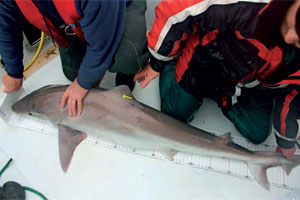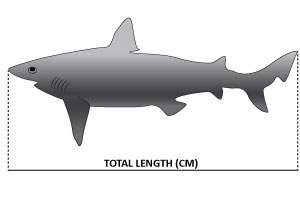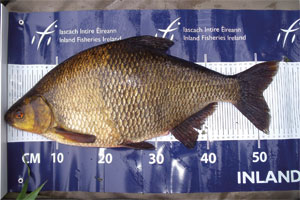Length-Based Specimens – Conservation Specimens
The Irish Specimen Fish Committee have made major advances in recent years in fish identifications and weighting by offering genetic identification for several species (where a body may have been required in the past) and accepts good quality photographs for most species to confirm identification. Verified identification is very important to ensuring high quality specimen data. Anglers are increasingly conservation orientated and submissions have been received by the ISFC from anglers and others in recent years regarding the desirability of using length as a proxy for weight.
For ALL SPECIES ≤ 1 kg or ≤ 40 cm TL or FL, the fish must be weighed and claimed in grammes (g) and cm.
How to make a Length-Based Specimen Claim
| 1. | Attach a durable, accurate measuring device to the deck of the boat or use a fish conservation mat (available from Inland Fisheries Ireland or other suppliers). Inland Fisheries Ireland sells measuring mats online at cost (€19.99) plus postage (€9.00) for a total of €28.99. Two versions are available a 170cm mat ideal for pike, tope, smoothhound and spurdog anglers (and all the other fish unlikely to exceed 170cm) and a 230cm version ideal for sharks and skate. Buy online at https://permits.fishinginireland.info/product-category/measuring-mats/ |
| 2. | Place the fish, belly down on the measuring device with its dorsal caudal lobe depressed into line with its body axis (see Figure 2.1). Figure 2.1: Shark being measured on IGFA measuring mat |
| 3. | Record the total length, measured as a point to point distance (not over the curve of the body) from the snout tip to the tip of the dorsal caudal lobe (see Figure 3.1). The snout tip must be placed against a perpendicular front bar or plate to index the 0 cm measurement accurately (see Figure 3.2). Figure 3.1: Total length measured as a point to point distance  Figure 3.2: Bream being measured on Inland Fisheries Ireland Fish Conservation Mat |
| 4. | Fill out relevant details of claim using the existing claim form. Tick box ‘Length based specimen claim’ in Section 1 of form to specify that length only is being measured. |
| 5. | Photograph(s) must accompany each length-based specimen claim. Photograph(s) showing fish placed belly down on properly extended measuring device with snout against perpendicular bar or plate with the actual recorded length (cm) visible. |
| 6. | The sex of all sharks, skates and rays must be recorded. Males can be identified by their claspers (modified pelvic fins) which are thin elongated paired fins situated behind the pelvic fins. Females do not have claspers but have an opening between the pelvic fins. |
The ISFC requests that all specimen fish are measured according to table below
Species | Measurement (cm) required | Technique |
| ALL Marine species (except blue sharks and porbeagle sharks) | Total length | Place fish on top of measuring device and measure in an straight line from tip of snout to end of tail |
| ALL Marine species (except ray and skate) | Girth | Measure greatest girth using tape measure - usually in front of dorsal fin |
| Ray and skate | Wingspan | Place fish on top of measuring device and measure from wingtip to windtip |
| ALL Freshwater species | Forklength | Place fish on top of measuring device and measure from tip of snout to middle rays of tail |
| ALL Sharks, Rays and Skates | Sex - state on claim form if fish is male or female | Males can be identifies by their claspers (modified pelvic fins) which are thin elongated paired fins situated behind the pelvic fins. Females do not have claspers but have an opening between the pelvic fins. |
Where the angler can be proactive in claiming specimens?
The Irish Specimen Fish Committee encourages all anglers to return specimen fish alive whenever feasible. ISFC rules do not require that all fish species are killed to claim a specimen. This is a misconception by many with regard to claiming a specimen. Bodies are required for a small number of species but good quality photography is alleviating this requirement and most anglers have access to good cameras.
Angler preparedness is key to claiming a specimen and ISFC is keen to assist anglers to practice catch and release of specimens. If the angler has a certified personal scales* he can weigh the live specimen on land and return it alive to the water. Fish caught on a boat require to be weighed on terra firma (i.e. point of departure, island, rocky outcrop) to ensure weights are accurate as fish cannot be weighed accurately “on board”. Most coarse fish, pike and sea anglers are well versed in weighing specimens and have personalised or certified club weighing scales with them when angling. Trout and salmon anglers need to embrace this approach so that they can practice catch, weigh, photograph, release and claim their specimen fish.
